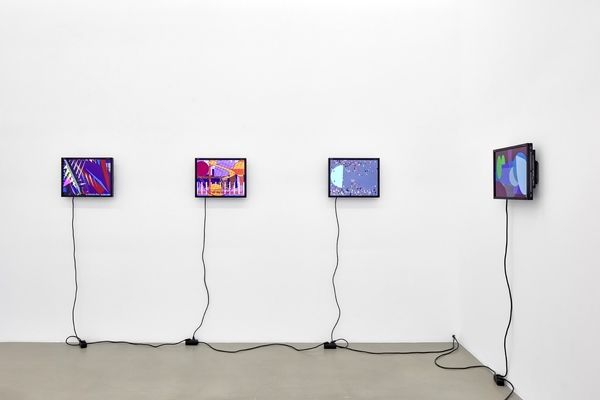Paintings & digital works by Samia Halaby at Sfeir-Semler Gallery
ArtDayME: The exhibition "Samia Halaby: Fragments of time paintings & digital works" is open until August 24 at the Sfeir-Semler Gallery in Hamburg.
Born in 1936 in Jerusalem, Samia Halaby left Palestine with her parents in 1948, arriving in the USA in 1951. After a BA in Design at the University of Cincinnati (1959), she studied art and painting, at the Michigan State University in East Lansing (graduating in 1960), and then at the Indiana University in Bloomington (graduating in 1963). Throughout her career, she held various teaching positions from 1962 onwards, and was part of the faculty at Indiana University, the University of Hawaii, Kansas City Art Institute, the University of Michigan, The Cooper Union, and the University of South Florida among others. She introduced undergraduate studio art program to art departments throughout the Midwest and was the first full-time female associate professor at the Yale University School of Art between 1973 and 1982.
In the 1960s and 1970s, her deep interest in perception leads her to explore in her work the effect of light on objects, the illusion of roundness on plane surfaces, or the play of depths, distances, and horizon lines of a painting. In 1985, her stay in Hawaii as a visiting artist at the University marks a turning point in her practice. Her encounter with intense light, exuberant nature, vivid colors, and the motion of the island totally transforms her painting style: breaking-free from the traditional flat plane she starts working in space, cutting out the fabric to create shaped canvases and three-dimensional sculptural paintings, all in very intense colors.
“I adopted the exploration of painting by programming a computer as a fully mature artist, and intended programming as a new medium for a millennia old discipline with primary usefulness in human culture – pictures.”
Driven by her curiosity for technological advancement, as well as by her will to evolve with her times, she decides to use the most advanced tools available to her then and begins in 1983-1984 to teach herself coding. In 1986, she purchases an Amiga 1000 computer and, playing with time, space, and movement, she starts to write codes which would animate shapes, colors, and even sounds on her computer screen. Expanding the visual language of abstraction, she creates between 1986 and 1989 a series of 57 kinetic paintings: each line of code provokes a shape or pattern in a primary color to appear, move or repeat on the screens, sometimes accompanied by early computer chimes and beeps embedded in the encoding.
These experimentations with computer-generated visuals naturally evolve into the Kinetic Painting Program in the 1990s. Instead of coding single paintings, Halaby transforms the keyboard of her PC into a live digital painting instrument, which she uses for her performances with the Kinetic Painting Group. During these performances, the artist presents digital paintings in real-time, hitting digits on her keyboard to provoke a shape, line, or pattern to appear, move, shift color, or repeat on the screen in front of the audience, accompanied by live musicians improvising a sound score.
From the mid-1980s onwards, the seriality and systematic approach in the computer-generated images have a transformative effect on her painting style: her paintings lose their center and become constructed by repetitions of single motifs that cover the surface, as if they could go on infinitely beyond the edge of the canvas. They also start showcasing the intense color palette that becomes hers. She composes her paintings in the same way she codes her kinetic works: constructing basic shapes, using primary bright colors, into indefinitely repeating patterns. Made of deconstructed, grouped, or overlapped patterns and shapes, the vibrancy of their yellows, blues, reds, or purples responds to the kinetic works shown on screens, highlighting the artist’s relentless quest to capture the essence of motion and of light - and its impression on our retinas.
By putting in dialogue the digital works of the 1980s with recent canvases form the 2020s, the exhibition underscores the links between the different phases in the artist’s practice. It also highlights her unwavering exploration of abstraction: Samia Halaby is a very particular, innovative figure within her generation of artists. In over six decades she constantly foregrounded works and techniques and, in retrospect, was working in the zeitgeist of her time throughout her career.












LEAVE A RELPY